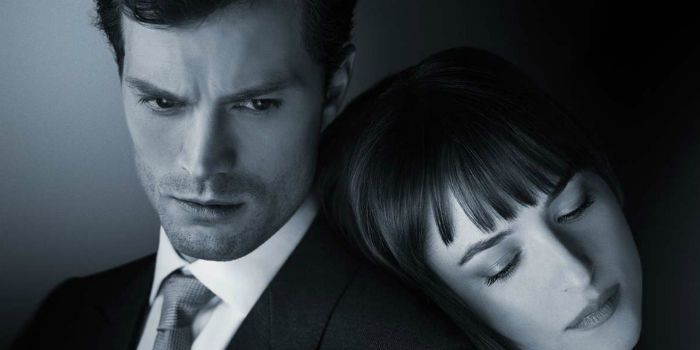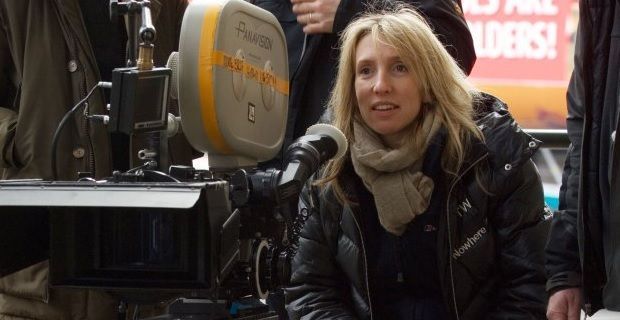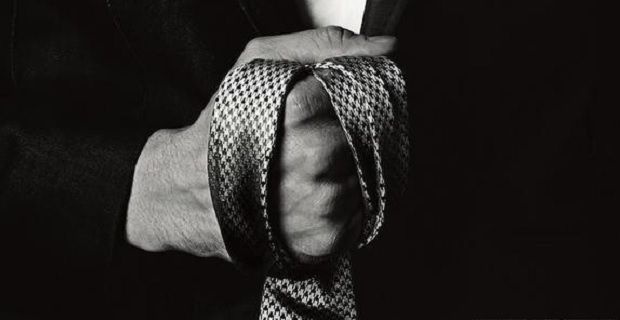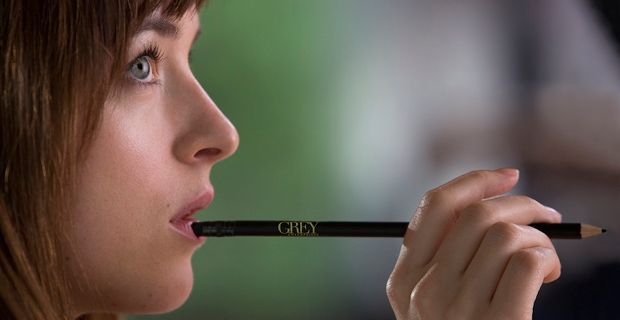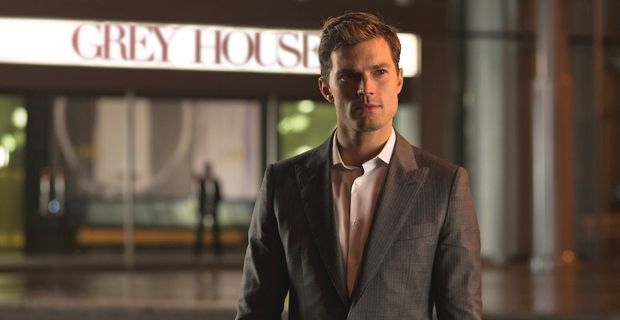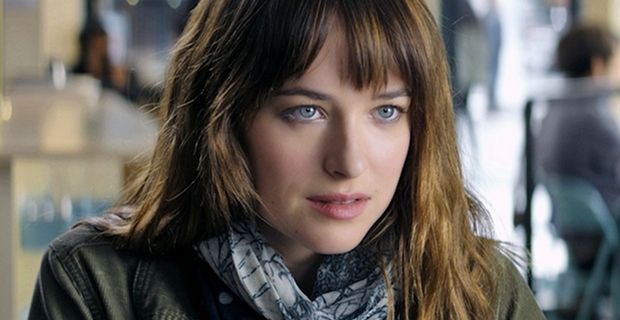Christian Grey is leaning over, his hands braced on a table, with his back to Anastasia Steele. It's the emotional climax of Fifty Shades of Grey: Christian and Ana have enjoyed a passionate and tumultuous romance, but it has led them both up to this point of insurmountable conflict. Ana is upset, questioning him, demanding to know why he can't have sex like a "normal" person.
Without looking at her, Christian replies, "Because I am fifty shades of f***ed-up."
A short silence follows: the sound of 200 people holding their breath. It's two days after Fifty Shades of Grey first hit theaters and almost all the seats are filled. Someone breaks first. The silence is filled with a single stifled, disbelieving snigger; and then, as if given unspoken permission, the rest of the theater is joining in and the collective laughter is drowning out whatever Ana says in response to Christian's dramatic declaration.
It's possible that there are a couple of dedicated Fifty Shades fans sitting somewhere in the back and fuming at the disrespectful response to a line that was lifted directly from the book. However, even if they did make themselves known, they would probably be drowned out by the rest of the crowd.
There have been two distinct types of laughter from the audience over the last two hours: pleasantly surprised laughter in response to Fifty Shades of Grey's moments of goofy self-awareness and wry self-deprecation; and groaning, embarrassed laughter every time something awful, cheesy or clichéd is uttered. The audience swerves between laughing along with Fifty Shades of Grey, and laughing at it. Welcome to the experience of watching this movie.
It's no coincidence that Fifty Shades of Grey feels like a film that's at war with itself. When author E.L. James' agent Valerie Hoskins was negotiating with Universal over the movie rights, she said that her main goal was "to protect the material and its manifestations into movies. To make sure that, as E.L. said, she would be all over it like a rash."
For once James' description wasn't at all florid, because her influence is indeed all over Fifty Shades of Grey like a rash. It's a fungal infection that crops up awkwardly in patches amid a film that's desperately trying to break free of its source material. Screenwriter Kelly Marcel and director Sam Taylor-Johnson were partially successful at turning a pretty terrible book into a coy, self-consciously humorous look at female sexuality and the emotional and political connotations of kink, but there are frequent moments in Fifty Shades of Grey where the film is jerked back into cringeworthy melodrama, as though someone has just tugged on the choke chain.
In essence, that's exactly what happened.
"[James] was given a lot of power, and she used every opportunity to flex that power," an inside source told The Hollywood Reporter in an article detailing the author's excessive interference. "It was really challenging to control E.L.'s — I don't want to say 'crazy' but — impulsive instincts."
A profile by Vanity Fair on the creative forces behind Fifty Shades of Grey corroborates this account and fleshes it out further. James would send Fifty Shades of Grey's Oscar-winning costume designer Mark Bridges pictures of the jeans that Christian should wear and advice on how they should be tailored. Bridges says that he "took her suggestions seriously," but that he was disappointed when the author vetoed the double-breasted suit that he had planned for Christian to wear when the character first appears in the film, on the grounds that it wasn't sexy enough.
"She has such a powerful vision that if we changed even the colour of a dress it would really unsettle her," Taylor-Johnson explained in an interview with HeyUGuys. "It was difficult being reminded about the arc and the story constantly." Given the frequently baffling ups and downs of the plot and character arcs that James laid out, it's little wonder that Taylor-Johnson didn't much enjoy being forced to adhere to them.
"We battled all the way through," Taylor-Johnson told Vanity Fair, referring to James' habit of showing up on set every single day to offer her input. "She’d say the same. There were tough times and revelatory times. There were sparring contests. It was definitely not an easy process, but that doesn't mean to say that it didn't come out the right way." The final caveat is a couple of negatives away from a declaration that Fifty Shades of Grey did come out the right way.
Taylor-Johnson also says that she had several people express surprise that she hadn't just quit the project altogether, but after taking four years off following the release of Nowhere Boy to focus on her family, she didn't have a wealth of options when she returned to Hollywood.
Although Fifty Shades of Grey already has two sequels green lit, there's no indication yet that Taylor-Johnson will direct either of them; and hopefully, she'll move on to better things. Fifty Shades of Grey is about as good as an adaptation from that particular source material could be when produced under such strained circumstances, and if nothing else the film works well as a showcase for the talents of its screenwriter, its director, and its two leads.
It's not really James' fault that Fifty Shades of Grey has received only a middling response from critics. Fundamentally, it's the fault of the higher-ups at Universal who agreed to a deal where the author of a book would have so much creative control over the film adaptation of that book. It's frankly absurd that Taylor-Johnson was put in a position of not only having to constantly argue with James about how to direct the film (the job that Taylor-Johnson was hired to do), but that she was also repeatedly overruled.
Universal put final decisions over the direction of a film into the hands of a person who not only knew nothing about filmmaking, but was capable of writing sentences like: "My inner goddess is doing the merengue with some salsa moves," looking back over them and thinking to herself, "Yes, that's a keeper."
It's far from the first time that an author has insisted that they know what's best for the adaptation of their book. According to Fifth Avenue, 5AM, Sam Wasson's account of the making of Breakfast at Tiffany's, Truman Capote originally wanted Audrey Hepburn's role to go to Marilyn Monroe and for himself to star opposite her as the male lead, despite the fact that he had no acting experience. Producer Marty Jurow gently dissuaded Capote, and the male lead was instead played by George Peppard.
There have been many great adaptations that were disliked or even hated by the author of the original novel (Stanley Kubrick's The Shining being perhaps the most famous example), but many of those films were excellent in their own right and flourished under a transformative approach to the source material. Even the best novelist in the world isn't automatically the best authority on how to adapt their works, because writing a book and making a film require vastly different skill sets.
It's a shame that Fifty Shades of Grey ended up being so tightly anchored to James' will, because films that explore and appeal to female sexuality are an uncommon breed in mainstream cinema. Ask someone for examples of the female gaze in recent movies and they'll usually point to Magic Mike (a movie about a man, directed by a man) and that one moment in Thor (also about a man, also directed by a man) when Thor takes his shirt off. Beyond that, there's not much other than Twilight. Talk about slim pickings.
Fifty Shades of Grey, if nothing else, breaks the mold. It's a film about a woman, scripted by a woman, directed by a woman, based on a book by a woman and catered more or less exclusively towards women. In the overwhelmingly male-dominated Hollywood film industry it's extraordinarily rare to see that many women's names above the line; and despite not being a very good movie, Fifty Shades of Grey's record-breaking box office numbers demonstrate the money-making power of appealing to a massive and largely untapped demographic.
Fifty Shades of Grey is in theaters now.

